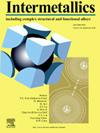Ti-6Al-4V夹层脉冲扩散焊对异种TiAl/Ti2AlNb接头强度的显著提高:多方面强化机制和高温性能
IF 4.3
2区 材料科学
Q2 CHEMISTRY, PHYSICAL
引用次数: 0
摘要
高强度TiAl/Ti2AlNb接头的开发是制造新型轻质、耐高温涡轮部件的关键和具有挑战性的研究前沿。在这项研究中,我们使用Ti-6Al-4V箔作为不同TiAl/Ti2AlNb接头的脉冲电流扩散键合(PCDB)的中间层,该策略取得了显着的结果。与之前报道的TiAl/Ti2AlNb接头相比,新开发的接头在室温和高温下的抗拉强度都有很大提高。其中,最优的PCDB接头在700℃时室温强度为607.8 MPa,高温强度为527.9 MPa。这种高强度接头的界面微观结构具有独特的组织特征。层间由岛状αp相和层状α+β相组成,两侧的扩散键合层分别由双层α2+α相和针状α2强化的β相组成。关节的强化机制是多方面的。它们包括固溶强化和界面微观结构的二相强化,界面内相组成的优化。中间层的加入引起的热应力的降低也被认为是高温强度提高的原因之一。这项研究不仅为高性能TiAl/Ti2AlNb接头的设计和制造提供了见解,而且为其在尖端航空航天和高温工程领域的更广泛应用提供了参考。本文章由计算机程序翻译,如有差异,请以英文原文为准。
Significant strength improvement in dissimilar TiAl/Ti2AlNb joints by pulsed-current diffusion welding with Ti-6Al-4V Interlayer: Multifaceted strengthening mechanisms and high-temperature performance
The development of high-strength TiAl/Ti2AlNb joints represents a pivotal and challenging research frontier in the fabrication of novel lightweight, high-temperature-resistant turbine components. In this study, we employed Ti-6Al-4V foils as an interlayer for the pulsed-current diffusion bonding (PCDB) of dissimilar TiAl/Ti2AlNb joints, a strategy that yielded remarkable results. The tensile strengths of the newly-developed joints at both room temperature and elevated temperatures showed substantial improvements compared to previously reported TiAl/Ti2AlNb joints. Specifically, the optimal PCDB joint exhibits a room-temperature strength of 607.8 MPa and a high-temperature strength of 527.9 MPa at 700 °C. The interfacial microstructure of this high-strength joint has unique structural features. The interlayer consists of an island-distributed αp phase and a lamellar α+β structure, while the diffusion bonding layers (DBLs) on both sides are respectively composed of the bilayered α2+α phases and the β phase strengthened by acicular α2. The strengthening mechanisms of the joints are multifaceted. They encompass solid-solution strengthening and second-phase strengthening of the interfacial microstructure, optimization of the phase composition within the interface. The reduction of thermal stress caused by the addition of the interlayer is also considered a reason for the improvement of high-temperature strength. This research not only furnishes insights into the design and manufacturing of high-performance TiAl/Ti2AlNb joints but also serves as a reference for their more extensive applications in cutting-edge aerospace and high-temperature engineering domains.
求助全文
通过发布文献求助,成功后即可免费获取论文全文。
去求助
来源期刊

Intermetallics
工程技术-材料科学:综合
CiteScore
7.80
自引率
9.10%
发文量
291
审稿时长
37 days
期刊介绍:
This journal is a platform for publishing innovative research and overviews for advancing our understanding of the structure, property, and functionality of complex metallic alloys, including intermetallics, metallic glasses, and high entropy alloys.
The journal reports the science and engineering of metallic materials in the following aspects:
Theories and experiments which address the relationship between property and structure in all length scales.
Physical modeling and numerical simulations which provide a comprehensive understanding of experimental observations.
Stimulated methodologies to characterize the structure and chemistry of materials that correlate the properties.
Technological applications resulting from the understanding of property-structure relationship in materials.
Novel and cutting-edge results warranting rapid communication.
The journal also publishes special issues on selected topics and overviews by invitation only.
 求助内容:
求助内容: 应助结果提醒方式:
应助结果提醒方式:


